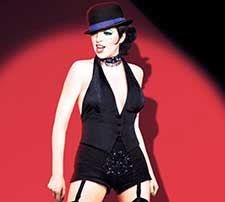Hindsight is 20-20
Not all films that go on to become classics are greeted with rave reviews.
I set about looking at various motion pictures of note that on their arrival garnered less-than-ecstatic appraisals from national film critics. These pictures include an iconic screen musical, a sci-fi classic, an almost universally revered movie, and a lesser-known social-problem film that helped alter the course of human history.
How do you solve a problem like Pauline Kael?
The March 2 golden anniversary of The Sound of Music got me thinking about just how sharp the critical daggers hurled at a much-loved film can be.
None was more cutting than the attack on the Von Trapp family musical by the emerging queen of journalistic film criticism, Pauline Kael. Writing a 1966 retrospective review of the film for McCall’s magazine, Kael retitled it “The Sound of Mucus,” and referred to its popular success as “a sugar-coated lie that people seemed to want to eat.”
McCall’s immediately dismissed her. Kael went on to review for The New Republic before landing at The New Yorker magazine where, between 1968-91, she established her reputation as a critic with a lively, unconventional writing style that included a passionate regard for favored directors and writers, and an equally passionate disregard for those whose films she disliked and which she didn’t hesitate in taking down — rather brashly.
This year will bring us the seventh chapter in the Star Wars science-fiction franchise, in a new work titled Star Wars: The Force Awakens. Here are some excerpts from what Kael said in 1977 about George Lucas’ first formative effort in the series:
“The loudness, the smash-and-grab editing, the relentless pacing drive every idea from your head; for young audiences Star Wars is like getting a box of Cracker Jack (sic) which is all prizes … An hour into it children say they’re ready to see it all over again; that’s because it’s an assemblage of spare parts. It has no emotional grip. Star Wars may be the only movie in which the first time around the surprises are reassuring. (Going a second time would be like trying to read Catch 22 twice.) Even if you’ve been entertained, you may feel cheated of some dimension — a sense of wonder perhaps. It’s an epic without a dream.” (Reprinted in Kael’s anthology of reviews, When the Lights Go Down, 1980.)
Bowled over? Not so much
Pauline Kael wasn’t the only critic of her day to disparage what would become a screen classic, or to call into question filmgoers’ tastes in the critiquing of a film. John Simon, who reviewed film and theater for a number of magazines, including New York magazine and National Review, at times appeared to be in a competition with Kael in the category of “Truly Shocking Reviews.” Simon not only impugned audience tastes but also tended to attack actors’ physical attributes. In his review of Taxi Driver (1976), Simon noted Cybill Shepherd appeared to have put on weight, and described her on-screen image as akin to “Mussolini in drag.”
As a critic Simon exhibited a number of traits: erudition, wit, conviction — but also caustic and acerbic tendencies that did not always set well with fellow critics or with the film world. Nowhere was Simon more stinging than in his review of Bob Fosse’s Cabaret (1972), a film adapted from the 1966 Broadway musical. For the last half-century Cabaret has inspired more than 20 major stage revivals worldwide. Fosse’s film would win eight Oscars — more than any other film not to receive the Best Picture Award. Understandably that Oscar went to The Godfather. Here’s how Simon went after Cabaret:
“Plain, ludicrously rather than pathetically plain, is what Miss Minnelli is. That turnipy nose overhanging a forward-gaping mouth and hastily retreating chin, that bulbous cranium with eyes as big (and as inexpressive ) as saucers … And given a matching figure — desperately uplifted breasts, waist indistinguishable from hips — you cannot play Sally Bowles. Especially if you have no talent.”
Simon went on to weave into the review a double-edged comment on Minnelli’s lineage that included a stab at her fans and the creators of Cabaret: “Miss Minnelli has only two things going for her, a father and a mother who got her there in the first place, and tasteless reviewers and audiences who keep her there. She can’t even sing Kander and Ebb’s admittedly inferior songs…”
It’s hard to know what compulsions were behind Simon’s aggressive stance on Cabaret, but it’s a given that responses to a motion picture — from filmgoers and critics alike — are understandably subjective and individualistic. But one can set Simon’s overriding, mean-spirited negativity against other contemporary critics of the day, for example, Roger Ebert. Ebert described his own style as centered on a “value-oriented” response in critiquing a motion picture, suggesting an attitude of fairness. His reviews, he said, were meant to be read as “relative, not absolute.” He chastised Simon for having “made it a specialty to attack the way actors look. They can’t help how they look any more than John Simon can help looking like a rat.”
Citizen lame
Sometimes a negative review of a breakthrough film is the result of the critic having been caught off guard by cinematic innovation of historical proportions. Such was the case with Bosley Crowther’s May 2, 1941, New York Times’ review of Citizen Kane, often ranked in polls as the greatest film of all time.
Crowther argued Orson Welles’ film failed “to provide a clear picture of the character and motives behind the man about whom the whole thing revolves … (It is) clearly revealed that the man was in some way consumed by his own terrifying selfishness. But just exactly what it is that eats upon him, why it is there, and for that matter, whether Kane is really a villain or a social parasite is never clearly revealed. And the final poignant identification of ‘Rosebud’ sheds little more than a vague sentimental light upon his character. At the end Kubla Kane is still an enigma — a very confusing one.”
I see this not as a harsh critique but rather as a time-capsule review, one that helps shed light on the state of film criticism at the moment and the emerging possibilities for an ever-evolving art form. Welles’ film defied all the expected rules of the well-made screen scenario — unifying plot structure, clarifying motivations for the central protagonist, rising crises, and climactic denouement.
In breaking from convention Welles’ mosaic treatment of Charles Foster Kane was intended as a philosophical inquiry into the complexity and unknowability of any human being’s life. Although at the time Crowther failed to grasp the brilliance of Citizen Kane, he admired its “consummate theatricality” and said, “You shouldn’t miss this film.” He later revised his opinions altogether (as many critics often will) and gave Citizen Kane a prominent place in his reflective critical anthology The Great Films: 50 Golden Years of Motion Pictures (Putnam, 1971).
Time capsule
In looking back at negative reviews of significant films there is one in Time magazine that for me stands out in ways unlike any of the above. It can be seen as another time-capsule review with remarkable historical and sociological implications. The film was Victim, a 1961 British social-problem thriller that focused on the 19th-century law against “gross indecency” that sent homosexual men to prison.That law appeared as a key plotting element in this year’s Best Picture Oscar nominee The Imitation Game about the life of Alan Turing. This brilliant mathematician played a pivotal role in breaking Nazi codes and shifting the tides in World War II. But despite his status as a war hero, Turing was prosecuted in 1952 for “homosexual acts” and was sentenced to either a prison term or chemical castration. Turing chose castration, followed by his likely suicide.
Less well-known than the classics above, Victim merits some detailed discussion of the script and further background history that together help elucidate the significant sociopolitical roles the film would play in the United Kingdom. In the 1950s and ’60s, about 90 percent of the blackmail cases in Britain involved homosexual men. Although the government’s Committee on Homosexual Offences and Prostitution had recommended in its 1957 report to Parliament the decriminalization of homosexuality, it would be a decade before legal action was taken. The law continued to serve as a charter for blackmail, and it was in this context that Victim was conceived. It would become the first major British film to have a visible contemporary man as an upfront homosexual protagonist — and a very significant one in the presence of screen idol Dirk Bogarde in the lead role.
Law and disorder
The script by Janet Green and John McCormick took on the widespread blackmail extortion scams that occurred when men identified as homosexuals paid bribes to corrupt law enforcement officials rather than face prison. The plot was daring and courageous. Bogarde portrayed Melville Farr, a prominent lawyer in late 1950s London, married but with a secret homosexual past. Farr decides to fight the 19th-century statute after a young man to whom he’s been attracted is discovered as a homosexual.
When the young man commits suicide Farr is driven to act against his self-interests of career and marriage. He sets out, against great odds, to rally support for legal reform and bring about an end to the oppressive culture of blackmail extortion. Plotted around a suspenseful search to discover and reveal the ring of blackmailers, Victim conveyed its characters with sincerity and conviction and fully avoided familiar screen cliches and stereotypes. After its release, support of legal reform rose above 60 percent among British citizens. In 1967 the British government finally overturned the severe law against homosexuality.
Because of its liberal stance and its heroic display of a homosexual protagonist, Victim was denied a Code Seal of Approval when exported to the United States. The picture initially was relegated to art houses. While some British critics had seen flaws in Victim’s “thriller” approach and its lack of sexual details, none used the film for a personal critique of homosexuality like the one published in Time magazine Feb. 23, 1962. The stinging review was titled: “A Plea For Perversion?”
Time’s unnamed film critic writes, “Victim pursues with eloquence and conviction the case against an antiquated statute,” and then goes on to say, “but what seems at first an attack on extortion seems at last a coyly sensational exploitation of homosexuality as a theme — and what’s more offensive, an implicit approval of homosexuality as a practice. Almost all the deviates in the film are fine fellows — well-dressed, well-spoken, sensitive, kind. The only one who acts like an overt invert [“invert” was the term Victim used for homosexuals] turns out to be a detective.“Everybody in the picture who disapproves of homosexuals proves to be an ass, a dolt, or a sadist. Nowhere does the film suggest that homosexuality is a serious (but often curable) neurosis that attacks the biological basis of life. ‘I can’t help the way I am,’ says one of the sodomites in this movie. ‘Nature played a dirty trick.’ And the scriptwriters, whose psychiatric information is clearly coeval with the statute they dispute, accept the sick-silly self-delusion as medical fact.”
Speechless
What can one say, but to point out that reading old film reviews can be an educational experience.
The character of a film critique is subject to a number of factors — the personal disposition of the reviewer, individualized standards with regard to film expression, and evaluation of a work that takes into account the social and political climate of the time. Each of these factors, in differing ways, figures into the negative reviews of these significant films.
Postscript: A campaign by the producers and public supporters of The Imitation Game to win pardons for Alan Turing and the other nearly 50,000 homosexual men convicted under Britain’s 19th-century law has at the moment been stalled due to government concerns that some of those convicted may include pedophiles. According to a British newspaper report, Turing’s relatives have presented a petition to Downing Street, signed by more than half a million people, calling for a pardon for all prosecuted under the pre-1967 law. (The Guardian, Feb. 28, 2015.)







Dan O'Neill - 1974
Do you think John Simon attacked actors looks because he was such a physically ugly man himself?
It was kind of like Quasimodo shouting insults from the bell tower.
Reply
john constantino - 6
Simon was right about the film Cabaret. Just saw it in entirety finally last week. Minelli was completely unbelievable and uncompelling in her role. Her weird looks were distracting too. I think she let the whole film down. The other performances were good, esp. Joel Grey. Sally Bowles’ role in the film should have gone to the Broadway actress who played her on stage, Jill Haworth, who was a better singer (and better looking :). Academy must have have been besotted with the Garland/Minelli legend or movie hype to award Minelli & film with such an Oscar bounty. The Godfather ONLY won for Best Picture?
Reply